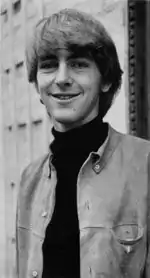Tara Browne
Tara Browne (4 March 1945 – 18 December 1966) was a London-based Irish socialite and heir to the Guinness fortune. His December 1966 death in a car accident was one inspiration[1] for the Beatles' song "A Day in the Life".[2]
Tara Browne | |
|---|---|
 | |
| Born | 4 March 1945 Dublin, Ireland |
| Died | 18 December 1966 (aged 21) London, England |
| Resting place | Luggala, Guinness Estate Wicklow, Republic of Ireland |
| Nationality | British/Irish |
| Occupation | Socialite |
| Known for | Guinness fortune heir |
| Spouse(s) | Noreen MacSherry |
| Children | 2 |
| Parent(s) | Dominick Browne, 4th Baron Oranmore and Browne Oonagh Guinness |
Early life
Browne was the son of The 4th Baron Oranmore and Browne, an Anglo-Irish peer and a member of the House of Lords who served in that house for 72 years, longer than any other peer up to that time, finally being evicted during government reforms in 1999; and Oonagh Guinness, an heiress to the Guinness fortune.[2]
Browne was a member of Swinging London's counterculture of the 1960s[2] and had stood to inherit £1 million at age 25.[2] In August 1963, at age 18, he married Noreen "Nicky" MacSherry, and had two sons, Dorian and Julian.
For his 21st birthday, he threw a "lavish" party at Luggala, the Gothic family seat in the Wicklow Mountains, where "two private jets flew the 200 or so guests to Ireland, including John Paul Getty, Mick Jagger, Brian Jones, Jones' then girlfriend Anita Pallenberg, and Paul McCartney."[2]
His life is captured by Paul Howard in the biography I Read the News Today, Oh Boy published in 2016.
Death
On 17 December 1966, Browne was driving with his girlfriend, model Suki Potier, in his Lotus Elan through South Kensington at high speed (some reports suggesting in excess of 106 mph/170 km/h). He was under the influence of alcohol and other drugs at the time. Browne failed to see a traffic light and proceeded through the junction of Redcliffe Square and Redcliffe Gardens, colliding with a parked lorry. He died of his injuries the following day. Potier claimed that Browne swerved the car to absorb the impact of the crash to save her life.
Following his death, his estranged wife Nicky launched a public legal battle for custody of their two young children; Browne's mother, Lady Oranmore and Browne, also sought custody. A judge eventually ruled that the boys should live with their grandmother.[2]
Beatles' song
The death of Browne is supposedly captured in the song "A Day in the Life" by The Beatles, which was released on their 1967 album Sgt. Pepper's Lonely Hearts Club Band. In a 1980 interview with Playboy magazine John Lennon said "I was reading the paper one day [...] the Guinness heir who killed himself in a car. That was the main headline story. He died in London in a car crash."[3] Lennon, who was a friend of Browne, read the coroner's verdict into Browne's death while composing music at his piano. It was this tragic news, which inspired him to write the following lines:
He blew his mind out in a car
He didn't notice that the lights had changed
A crowd of people stood and stared
They'd seen his face before
Nobody was really sure
If he was from the House of Lords
However, Paul McCartney had a very different inspiration for these lines, he said "The verse about the politician blowing his mind out in a car we wrote together. It has been attributed to Tara Browne, the Guinness heir, which I don't believe is the case, certainly as we were writing it, I was not attributing it to Tara in my head. In John's head it might have been. In my head I was imagining a politician bombed out on drugs who'd stopped at some traffic lights and didn't notice that the lights had changed. The 'blew his mind' was purely a drugs reference, nothing to do with a car crash."[4]
References
- McCartney: Songwriter ISBN 978-0-491-03325-1 p. 188
- "Obits:Nicky Browne". Daily Telegraph. 22 June 2012. Retrieved 27 June 2012.
- David Sheff (January 1981). "Playboy Interview with John Lennon and Yoko Ono". Playboy. Retrieved 15 April 2020. Cite magazine requires
|magazine=(help) - Miles, B (1997). Many years from now. Secker & Warburg; H. Holt & Co. ISBN 0-8050-5249-6.